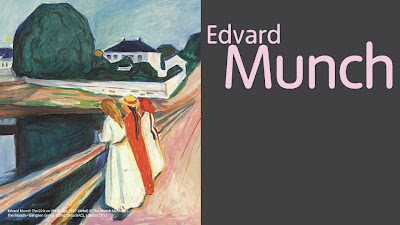Edvard Munch once said: I don't paint what I see, I paint what I saw...
..and he saw a lot.
I enjoyed very much going to the exhibition Edvard Munch: The Modern Eye. in the Tate Modern in London. He never broke free from his torments. True. But the point of the exhibition was to celebrate his modernity and to bring a broader perspective about him. In fact, "The Scream (see entries below) was not part of the exhibition
I learned a lot about his life and early events that shaped him, such as the death of his sister Sophie at 15 when he was 14. His mother had died of tuberculosis as well.
His remorse due to a love affair with a married woman when he was very young.
There were other dramatic episodes later one such as shooting that hurt his hand after the fight with a woman. The fight with a friend. His self portraits show a man having doubts, confused, serious. But ultimately Munch was determined to being himself.
He did not beautify reality (or his reality). As mentioned by The Independent "he portrayed raw emotion, alienation adn loss like no one else".
The modernity of Munch who lived most of his life in the 20th century is not always recognised. In fact many would considered a 19th century painter.
Photography, for example, fascinated him and the exhibition shows many photographs he made of himself. He loved going to the movies. We even watched some of his improvised filming of the streets of Oslo.
A whole room is devoted to explaining the way cameras influenced the way painted his subjects. Fr example, the workers on their way home. (This image does not do justice. When you have it in front of you you do feel the workers are moving).
This one was painted after he had a nervous breakdown and discovered the healing powers of light.
He endured a lot of criticisms in Norway. The country was not ready for him. Initially. Overtime he became an appreciated artists.
This painting, Madonna, was not in the Exhibition, and is probably my favorite one. I saw it in the Museum of Art in Oslo. It was a scandal when it hit the Oslo saloons.
He made several versions - a very modern thing much earlier than Andy Warhol who made reproduction of his art a central feature. The Munch Museum of Oslo owned a version that was stolen in 2004 (!) and recovered in 2006.
..and he saw a lot.
I enjoyed very much going to the exhibition Edvard Munch: The Modern Eye. in the Tate Modern in London. He never broke free from his torments. True. But the point of the exhibition was to celebrate his modernity and to bring a broader perspective about him. In fact, "The Scream (see entries below) was not part of the exhibition
I learned a lot about his life and early events that shaped him, such as the death of his sister Sophie at 15 when he was 14. His mother had died of tuberculosis as well.
His remorse due to a love affair with a married woman when he was very young.
There were other dramatic episodes later one such as shooting that hurt his hand after the fight with a woman. The fight with a friend. His self portraits show a man having doubts, confused, serious. But ultimately Munch was determined to being himself.
He did not beautify reality (or his reality). As mentioned by The Independent "he portrayed raw emotion, alienation adn loss like no one else".
The modernity of Munch who lived most of his life in the 20th century is not always recognised. In fact many would considered a 19th century painter.
Photography, for example, fascinated him and the exhibition shows many photographs he made of himself. He loved going to the movies. We even watched some of his improvised filming of the streets of Oslo.
A whole room is devoted to explaining the way cameras influenced the way painted his subjects. Fr example, the workers on their way home. (This image does not do justice. When you have it in front of you you do feel the workers are moving).
This one was painted after he had a nervous breakdown and discovered the healing powers of light.
He endured a lot of criticisms in Norway. The country was not ready for him. Initially. Overtime he became an appreciated artists.
This painting, Madonna, was not in the Exhibition, and is probably my favorite one. I saw it in the Museum of Art in Oslo. It was a scandal when it hit the Oslo saloons.
He made several versions - a very modern thing much earlier than Andy Warhol who made reproduction of his art a central feature. The Munch Museum of Oslo owned a version that was stolen in 2004 (!) and recovered in 2006.







